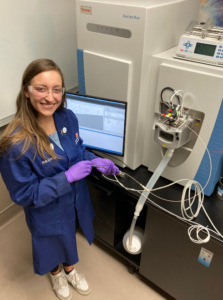Mike Callahan, an associate professor in the Department of Chemistry and Biochemistry, has been featured in two articles on the Boise State News webpage in the past couple of weeks. The articles referred to his recent publications about the research being conducted in the Callahan Lab, funded by the NASA Emerging Worlds Program.
The first article, released on October 23, 2023, discussed his work analyzing extraterrestrial meteorites. The project examined water-rich meteorites called carbonaceous chondrites which Callahan and his team analyzed for cyanide-containing compounds using state-of-the-art analytical instruments. This research was published in the ACS Earth and Space Chemistry journal. That article, “Cyanide Abundance and Soluble Organic Composition in Highly Aqueously Altered CM Chondrites” was co-authored by Patrick K. Schwartz, Karen E. Smith, and Boise State chemistry graduate student Rachel A. Reichow as a lead author.
When asked about her role in the project and the paper, Rachel had this to say, “This project was a huge learning curve for me. In order to be successful, I needed to learn two new techniques for sample preparation along with learning how to use new (to me) instruments both individually and in tandem. It did take awhile to become proficient while working independently but through this experience I have become more confident in my skill set, especially when tasked with a new project.” She also wanted to emphasize that “we were able to accurately measure cyanide abundance in water-rich meteorites as well as identify lots of interesting organic compounds. This knowledge could help guide future analyses of asteroid Bennu samples, which were recently returned by NASA’s OSIRIS-REx mission.”

On November 8, another article by Boise State News came out, discussing Callahan’s origin of life research. His publication, also in ACS Earth and Space Chemistry and titled “Addressing the Miller Paradox and the Prebiotic Synthesis of Nucleobases,” is a collaboration with Jim Cleaves, a chemistry professor at Howard University in Washington, D.C. This new study may help answer one of the longstanding paradoxes in origin of life chemistry, the Miller Paradox. Callahan was quoted as saying “I believe that this study is an important contribution to the origin of life field. I think it will help change a narrative that has been engrained in a lot of scientists for many decades now.”
Click on the above links to read both the Boise State News articles and the original publications from the Callahan Lab in the ACS Earth and Space Chemistry journal.
Congratulations to Dr. Callahan on his publications and his recognition by Boise State for his research. Of course, we’d also like to give a special shout-out to Rachel Reichow! She is doing fantastic work and we’re so proud of her for being published!